The seventeenth century in Europe was a period marked by profound social, economic, and political changes that significantly impacted the lives of its inhabitants, particularly the poor. Poverty was a pervasive issue across the continent, but its nature and the responses it elicited varied considerably from one country to another.
In certain regions, such as the Dutch Republic and England, parts of the century were characterized by economic growth and relative prosperity. The Dutch Republic, in particular, experienced what is often referred to as the "Dutch Golden Age"—a period of immense wealth generated through global trade, advanced shipping industries, and pioneering financial systems. This prosperity not only elevated the standard of living for many but also provided the resources necessary for more effective management of poverty. England, meanwhile, began expanding its colonial reach, which, despite its complexities, contributed to economic opportunities for some segments of the population.
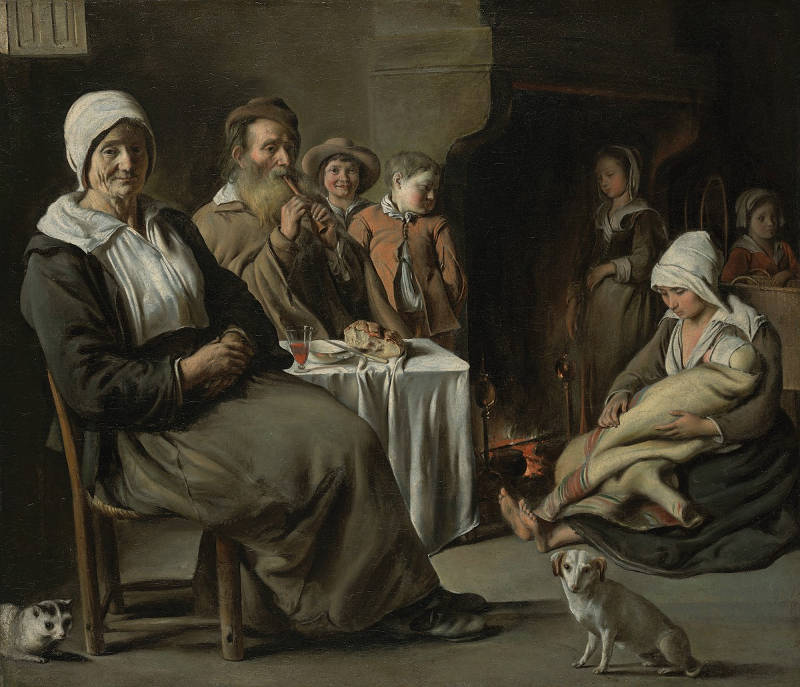
Louis (or Antoine?) Le Nain
c. 1642
Oil on canvas, 54.1 x 62.1 cm.
Kimbell art Museum, Fort Worth
Conversely, countries like Spain and numerous territories within the Holy Roman Empire faced economic decline and instability. Spain grappled with the depletion of its silver mines in the Americas and the financial burdens of prolonged military conflicts, leading to inflation and economic stagnation. The Thirty Years' War (1618–1648) devastated large parts of Central Europe, resulting in significant loss of life, destruction of property, and displacement of populations. These conditions exacerbated poverty and hindered recovery efforts.
Conversely, countries like Spain and numerous territories within the Holy Roman Empire faced economic decline and instability. Spain grappled with the depletion of its silver mines in the Americas and the financial burdens of prolonged military conflicts, leading to inflation and economic stagnation. The Thirty Years' War devastated large parts of Central Europe, resulting in significant loss of life, destruction of property, and displacement of populations. These conditions exacerbated poverty and hindered recovery efforts.
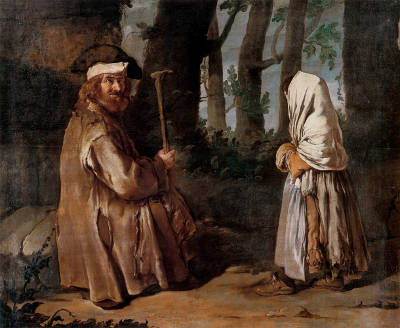
Giacomo Ceruti (known as Pitocchetto)
c. 1730–1735
Oil on canvas
Fondazione Brescia Musei, Brescia
The general causes of poverty during the seventeenth century were multifaceted. Economic fluctuations played a critical role; trade imbalances and the collapse of key industries led to widespread unemployment and reduced incomes. Wars and conflicts drained national treasuries, destroyed infrastructure, and disrupted agricultural production, further entrenching poverty. Additionally, famines and epidemics, such as recurrent outbreaks of the plague, decimated populations and undermined economic stability. The rigid social hierarchies of the time, rooted in feudal traditions, severely limited social mobility, effectively trapping the lower classes in poverty with little hope of advancement.
Responsibility for caring for the poor primarily fell to religious institutions, charitable organizations, and, increasingly, municipal authorities. The Church was central in providing relief, with monasteries and convents offering alms, food, and shelter to those in need. Beyond ecclesiastical support, guilds and confraternities—associations often based on trade or religious devotion—extended assistance to their members and the wider poor community. Some urban centers began to recognize the necessity of organized aid, leading to the establishment of poor laws and municipal assistance programs that sought to systematize relief efforts.
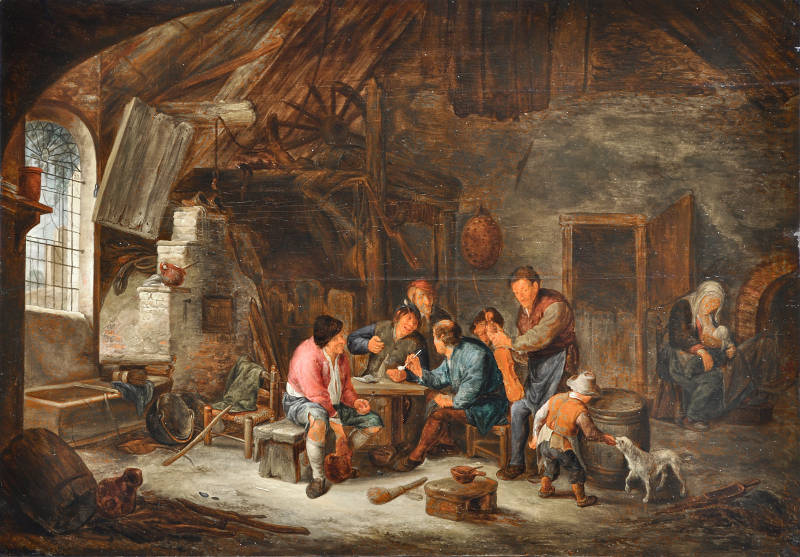
Attributed to Richard Brakenburgh
17th century
Oil on panel, 36.1 x 51.6 cm
Private Collection
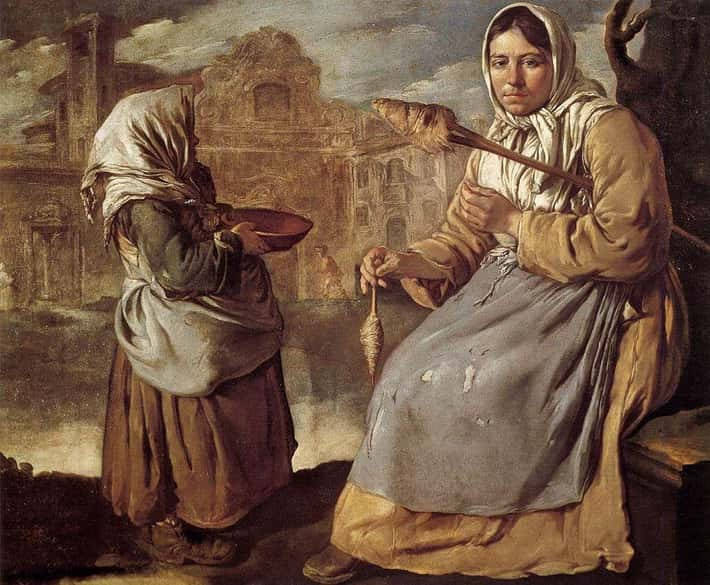
Giacomo Ceruti (Pitocchetto)
1720s
Oil on canvas, 134 x 159 cm
Private Collection
Societal perceptions of the poor were complex and often ambivalent. A common distinction was made between the "deserving" and "undeserving" poor. The deserving poor included individuals who were impoverished due to circumstances beyond their control, such as widows, orphans, the elderly, and the disabled. These individuals were generally considered worthy of charity and support. In contrast, the undeserving poor were often perceived as able-bodied individuals who were unemployed or homeless due to perceived laziness, moral failings, or criminal tendencies. This group faced stigmatization and harsher treatment, including punitive measures like confinement in workhouses.
Beliefs about the causes of poverty were deeply influenced by religious and moral frameworks. Many contemporaries viewed poverty as a manifestation of divine will, a test of faith, or a consequence of sin. Personal failings such as idleness, intemperance, or lack of virtue were frequently cited as explanations for an individual's impoverished state. However, there was also a growing, albeit limited, recognition of systemic factors contributing to poverty, including economic downturns and social inequities.
Poverty in the Netherlands
In the Dutch Republic, the experience and management of poverty exhibited notable differences compared to much of Europe. The country's economic prosperity provided a foundation for more effective and organized approaches to poor relief. Dutch society developed advanced social welfare systems that integrated the efforts of local governments, churches, and civic organizations. These institutions collaborated to provide assistance, reflecting a societal commitment to addressing poverty collectively.
The influence of Protestantism, particularly Calvinism, played a significant role in shaping Dutch attitudes toward poverty. Calvinist ethics emphasized hard work, discipline, and frugality while also underscoring a communal responsibility to care for the less fortunate. This religious backdrop fostered a cultural environment where aiding the poor was both a moral duty and a practical necessity for maintaining social cohesion.
High levels of urbanization in the Netherlands facilitated the development of municipal policies targeting poverty. Cities established workhouses, orphanages, and public assistance programs designed to provide not just immediate relief but also opportunities for the poor to contribute productively to society. Unlike in many other European countries where the Church was the primary provider of poor relief, the Dutch model was characterized by significant involvement of civic institutions and citizen participation.
Economic opportunities in the Dutch Republic further distinguished its experience of poverty. The booming economy created jobs in trade, shipping, and related industries, which mitigated unemployment and reduced the overall incidence of poverty. While social hierarchies and class distinctions certainly existed, the economic dynamism of the period allowed for slightly greater social mobility than in more rigidly structured societies. Trade and entrepreneurship were valued, providing avenues for individuals to improve their socioeconomic status.
In contrast, regions suffering from economic decline, war, and rigid social structures saw less effective management of poverty and fewer opportunities for the poor. The devastation wrought by conflicts like the Thirty Years' War left many communities without the resources to support the needy. The absence of coordinated relief efforts often resulted in greater hardship and social unrest.
Beggary in the Netherlands
In the Netherlands during the early modern period, begging was a visible and often contentious aspect of poverty, shaped by economic realities, religious beliefs, and government policies aimed at regulating the lower classes. Dutch society, like much of Europe, distinguished between the "deserving poor—those who could not work due to age, illness, or disability—and the "undeserving" poor, often seen as idle or morally suspect. This distinction profoundly influenced social attitudes and policy responses.
The Protestant Reformation, which had a significant impact on Dutch culture, emphasized personal responsibility and the moral value of labor. Begging was frequently viewed with suspicion, associated with laziness or moral failure. At the same time, Calvinist theology underscored the Christian duty of charity, especially toward those genuinely in need, such as widows, orphans, and the elderly. This dual perspective shaped the Netherlands' unique approach to poverty, where local systems of relief were often managed by church deacons or civic authorities, providing assistance to those deemed worthy while discouraging public begging.
Begging was most visible in the rapidly growing urban centers like Amsterdam, Leiden, and Rotterdam. These cities attracted large numbers of migrants and displaced rural poor seeking work, but not all could find employment, leaving many to rely on alms. In rural areas, begging was often seasonal, with itinerant laborers or displaced farmers seeking support during agricultural downturns or after poor harvests. The visible poverty in Dutch cities became a pressing concern as urban economies expanded but could not accommodate the increasing labor supply.
Municipalities in the Netherlands addressed begging through a combination of charity and regulation. Strict ordinances against vagrancy reflected a desire to maintain public order and discipline the labor force. Beggars who violated these laws faced penalties ranging from fines to imprisonment or expulsion from the city. Cities also established workhouses, such as the Spinhuis in Amsterdam, to provide employment for the poor and deter begging. These institutions aimed to reform individuals through labor while aligning with broader social and economic goals.
Despite the systems of relief and regulation, beggars in the Netherlands faced significant stigma. They were often depicted in art and literature as either pitiable figures deserving of compassion or as symbols of deceit and idleness. Dutch genre painters, including Jan Steen and Adriaen van Ostade, frequently portrayed beggars in their works, sometimes with humor, other times with sympathy, offering a nuanced view of poverty and the moral dilemmas it presented to society.
In the Netherlands, begging was both a practical reality for many and a source of social anxiety. The Dutch approach, balancing structured relief with strict regulation, reflected their broader efforts to address poverty while maintaining order and morality in a society undergoing rapid economic and demographic changes.
Understanding what the poorer classes ate during this time provides valuable insight into the social and economic fabric of Dutch society, with bread emerging as a central element in their daily lives.
Bread and the Poor
In the seventeetnh-century Netherlands, society was marked by significant economic growth and cultural development. However, this prosperity was not evenly distributed, and a substantial portion of the population lived in modest or poor conditions. Understanding what the poorer classes ate during this time provides valuable insight into the social and economic fabric of Dutch society, with bread emerging as a central element in their daily lives.
For the poor, the diet was predominantly simple and based on what was affordable and readily available. Bread was the cornerstone of their meals, consumed at almost every opportunity due to its filling nature and relative affordability. Unlike the wealthy, who enjoyed white wheat bread—a symbol of status and refinement—the poor ate dark bread made from rye, barley, or a mixture of coarse grains. This darker bread was denser and more nutritious, containing higher amounts of fiber and essential nutrients that were stripped away in the refining process of making white bread.
Beyond bread, the poor supplemented their diet with porridges and gruels made from oats, barley, or other grains. These meals were economical and could be easily prepared in large quantities to feed entire families. Legumes such as beans, peas, and lentils were also staples, providing much-needed protein when meat was a luxury they could seldom afford. Vegetables, particularly root varieties like turnips, carrots, and onions, were common due to their low cost and long shelf life. When available, the poor might consume small amounts of dairy products like milk and cheese, though these were often too expensive for regular consumption.
Fish, especially herring, played a significant role in the diet of the lower classes. The success of the Dutch fishing industry, particularly in herring, made this fish plentiful and relatively cheap. Herring was consumed salted or pickled, providing an essential source of protein and fats. Foraging for wild foods such as berries, nuts, and edible plants was another way the poor augmented their diet, especially in rural areas where access to wild resources was possible.
Picturing Poverty
During the seventtenth century, European artists increasingly focused on everyday life, with special attention to the poor. This trend reflected both a growing interest in social realism and the influence of religious and secular narratives about poverty. Venetian art of the sixteenth century had already begun to depict the poor prominently, often idealizing their humility and suffering to align with Christian values, particularly in religious contexts. These portrayals symbolized poverty as a sacred condition, associating the poor with Christ, while simultaneously reflecting efforts to exclude them from urban spaces. Secular charity was depicted hierarchically, emphasizing the role of patrician benefactors.
The widespread poverty caused by the Thirty Years' War further heightened awareness of the plight of the impoverished, inspiring compassionate works by artists such as Stefano della Bella and Rembrandt, who brought a personal and empathetic perspective to their depictions of humanity's hardships. Other artists, like the Le Nain brothers in France, portrayed the poor with stoic dignity, emphasizing their endurance and quiet acceptance of hardship.
However, some depictions veered toward a colder aesthetic curiosity, focusing on the decorative appeal of patched clothing and worn features, sometimes bordering on caricature. Artists like Adriaen van Ostade (1610–1685), linked poverty with spiritual desolation, while William Hogarth’s satirical works, such as Gin Lane (1751), used poverty as a vehicle for social criticism. Across these varied approaches, Baroque artists found in poverty a rich and multifaceted subject, blending compassion, critique, and aesthetic exploration.
Relief
The concept of poor relief administered by the Holy Spirit Masters (or Heilige Geestmeesters) has its roots in the Christian charitable tradition, particularly within the Roman Catholic Church. This form of poor relief was a part of the broader network of charitable activities in medieval and early modern Europe, aimed at supporting the needy, including the sick, the poor, widows, orphans, and the elderly.
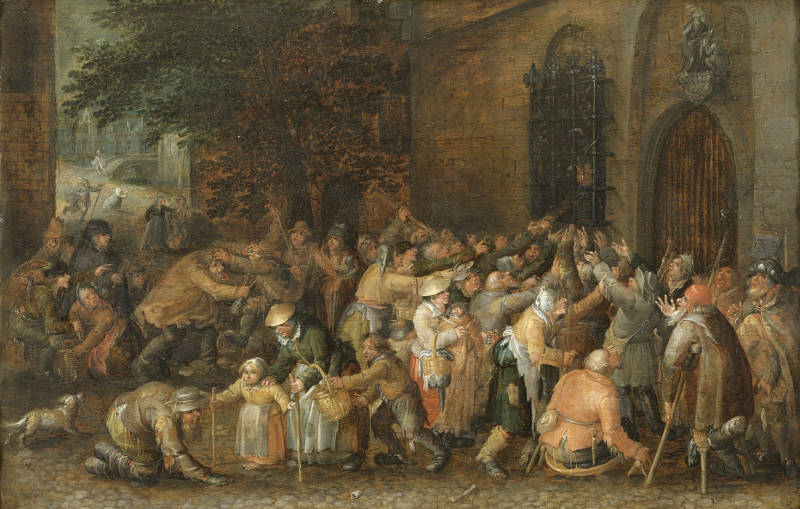
David Vinckboons
Unknown date
Oil on panel, 35 x 53 cm.
Nationalmuseum, Stockholm
The Holy Spirit Masters were responsible for organizing and distributing aid to the poor in their respective parishes or communities. The exact origins often varied by location, but many were founded as part of church activities. In Catholic regions, the Church played a central role in social welfare, and the organization of poor relief was often directly linked to local parishes. The Holy Spirit Masters were typically lay members of the community appointed or elected to manage the funds and resources dedicated to poor relief. Their activities were overseen by the church authorities but involved significant lay participation. The Holy Spirit Masters collected alms and donations from the community, including both monetary contributions and goods such as food and clothing. They also managed endowments and legacies left by wealthier members of the community for the benefit of the poor. These resources were then distributed to those in need, often through a system that assessed the needs of individuals and families within the community. Assistance could be in the form of direct financial aid, provision of food, clothing, housing, or support for the sick and disabled.
In the Dutch Republic, the Reformation led to a transformation in the organization of poor relief. After the establishment of the Dutch Reformed Church (Nederlandse Hervormde Kerk)The official consolidation of the Dutch Reformed Church occurred in the Synod of Emden in 1571, which was convened by the Dutch Protestants in exile. This event is often seen as the formal establishment of the Reformed Church as a distinct entity in the Netherlands. as the dominant religion, many of the functions previously performed by Catholic institutions, including poor relief, were taken over by secular or Protestant organizations. However, the basic principles of organizing and distributing aid to the needy continued. Local municipalities and Reformed churches established poor relief boards. These boards were often composed of deaconsA deacon is a member of the Christian Church's clerical order, ranking below a priest in many denominations. The deacon often holds a role that typically focuses on service and ministry to the congregation and community. Deacons are ordained to a ministry of service, which distinguishes them from priests or pastors, who are ordained to a ministry of word and sacrament. The specific duties of deacons can vary widely depending on the denomination, but they often include assisting in the church's liturgical functions, such as serving at the altar, distributing communion, and performing baptisms. (in Protestant areas) or continued under the auspices of Catholic charitable organizations in areas where Catholics were still a significant part of the population. This transition occurred against a backdrop of increasing poverty, exacerbated by a continuous influx of refugees from France and the Spanish Netherlands, which put additional pressure on the diaconate to seek financial support from the city government.
Delft: Vermeer, Poverty, and the Kamer van Charitate
Financial setbacks or the death of the breadwinner could easily sink a family into poverty. The poor also included many women whose husbands were away from home for extended periods, serving as soldiers in the Dutch States Army or on an East India Company ship. Fortunately for Vermeer, his mother-in-law provided the financial security many other inhabitants of Delft lacked.
Although one of Delft's upper class, Pieter Claeszoon van Ruijven, Vermeer's patron, was disqualified from high civic office because of his liberal Remonstrant Protestantism; even so he served for four years as a master of the Kamer van Charitate.
Vermeer faced significant financial difficulties during his life, especially in the final years leading up to his death in 1675, although with the assitance of his well-to-do mother-in-law and his earning from his porfession, he was ablet to lead a comfortable existance.
Members of the artist's extended family showed signs of financial strain as well. His mother, Digna Baltens, and his father, Reynier Jansz., experienced financial setbacks after the death of Reynier Jansz. Digna struggled to manage debts after her husband’s death, as highlighted by the delays in paying back even modest debts, such as a cloth purchase for mourning attire. Vermeer's entrance into the Guild of St. Luke was marked by a notably small down payment, which suggests financial pressure on the family.
Vermeer himself struggled to maintain his family’s financial stability, especially during the economic downturn caused by the war with France in 1672, which severely affected the art market. He reportedly "sold very little or hardly anything" during the last years of his life, leading to considerable debt. At the time of his death, he left behind significant debts, which his widow, Catharina Bolnes, had to manage. She described their financial situation as "desperate," having to sell paintings to pay creditors .
The family's financial difficulties were compounded by their reliance on the income from Catharina’s mother, Maria Thins, and other inheritances from her family. Vermeer was supported by the legacies and subsidies provided by Maria Thins, which likely helped sustain the family during difficult times. Without this assistance, it is doubtful that Vermeer could have supported his family given his modest income from painting.
"On December 16, 1675, the day Vermeer's coffin was placed in the family grave, an inscription was made under his name in the book recording death notations to Delft's Kamer van Charitate. The inscription in Dutch read: niet te halen, which may be translated as "nothing to be got."16 December 1675 "Johannes Vermeer kiinstschilder aan de Oude Lange dijck niet te halen" ("Johannes Vermeer painter on the Oude Lange dijck not to be collected") (Delft, Opperste kleed boek no. 74, Part II. tol. 50 v) "About half of the required income of the Kamer van Charitate came from donations, the rest from land ownership and various levies that have to be paid by the citizens of Delft. Thus, the Kamer receives "additional cents" on the city taxes on the sale of real estate, wine, and peat. A very creative levy was that of the so-called "best outer garment." The most expensive clothing item from the estate of every deceased resident must be handed over in a box to the Kamer van Charitate. From time to time, sales took place at the auction house, after which the proceeds flowed into the Kamer's coffers. Relatives were free, however, not to hand in the garment itself but to pay an amount determined by the appraisal of the auction house master, up to a maximum of one hundred guilders." "Bij Vermeer is niets te halen," Erfgoed Delft Stadsarchief. March 22, 2021. Accessed February 24, 2024. When Vermeer's mother and sister Gertruy died in 1670, the heirs (Vermeer and Antony van der Wiel) donated 6 guilders and 6 stuivers to the Commissioners for each of the deceased, a modest enough contribution but about average for a lower-middle-class family in Delft.John Michael Montias, "Chronicle of a Delft Family," in Vermeer, edited by Albert Blankert, Gilles Aillaud, and John Michael Montias, (Woodstock and New York: Overlook Duckworth, 2007).
Why was no donation made after the artist's death? When Vermeer's mother and sister Gertruy died in 1670, the heirs (Vermeer and Antony van der Wiel) donated six guilders and six stuivers to the Commissioners for each of the deceased, a modest enough contribution but about average for a lower-middle-class family in Delft. Was it because the widow, burdened with so many children, was too poor? Or because the family was Catholic and did not wish to contribute to an organization run by Calvinists?"John Michael Montias, Vermeer and His Milieu: A Web of Social History (Princeton, NJ: Princeton University Press, 1989), 337 According to Montias, the failure to donate was probably rooted in Catharina's insolvency, declared a few moths later.John Michael Montias, Vermeer and His Milieu: A Web of Social History (Princeton, NJ: Princeton University Press, 1989).